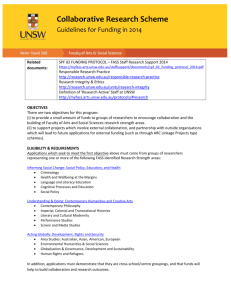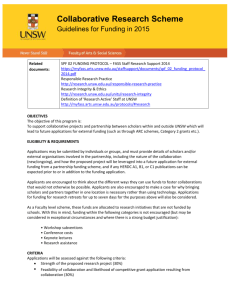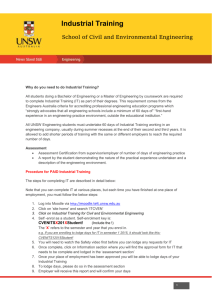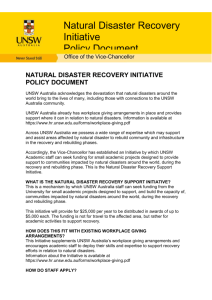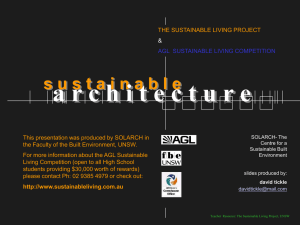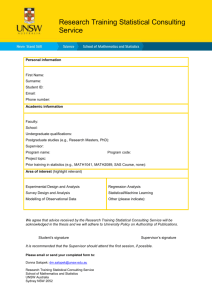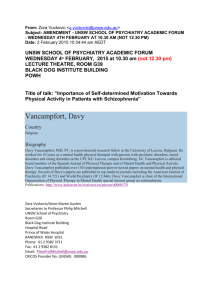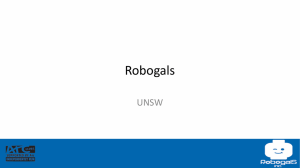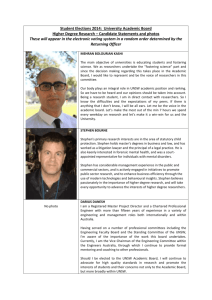BIOM9561 - Engineering
advertisement
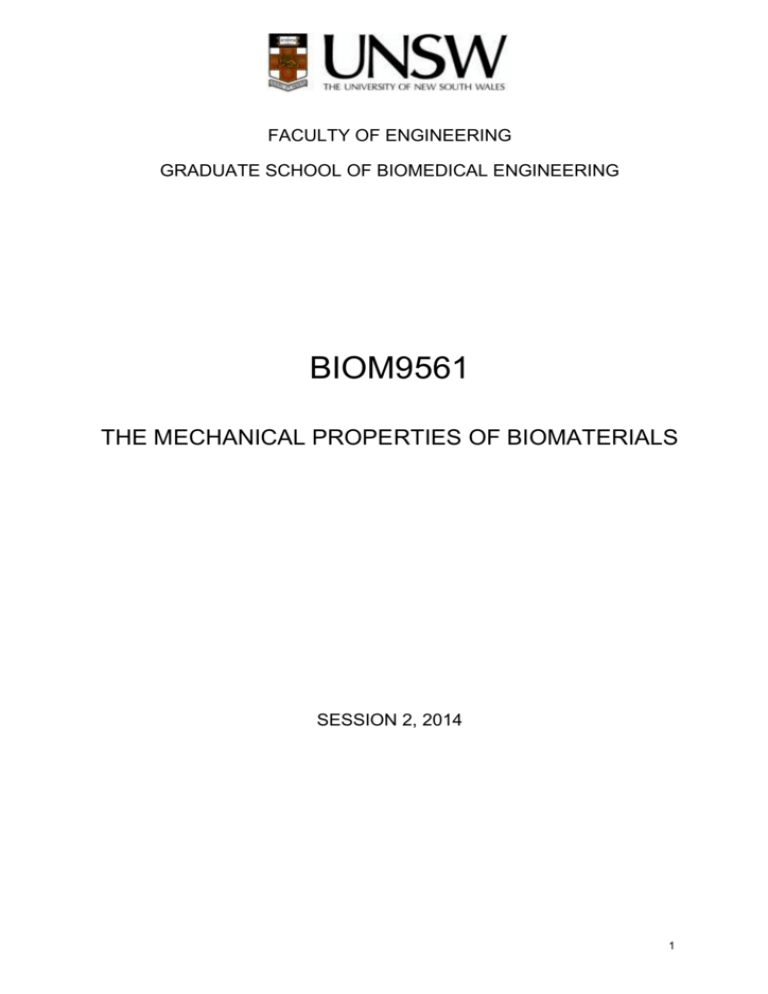
FACULTY OF ENGINEERING GRADUATE SCHOOL OF BIOMEDICAL ENGINEERING BIOM9561 THE MECHANICAL PROPERTIES OF BIOMATERIALS SESSION 2, 2014 1 Table of Contents 1. Information about the Course ......................................................................................................... 3 2. Staff Involved in the Course ............................................................................................................ 3 3. Course Details ................................................................................................................................... 4 4. Rationale and Strategies Underpinning the Course .................................................................... 5 5. Course Schedule ............................................................................................................................. 6 6. Assessment Tasks and Feedback ................................................Error! Bookmark not defined. 7. Additional Resources and Support ............................................................................................... 9 8. Required Equipment, Training and Enabling Skills ..................................................................... 9 9. Course Evaluation and Development .......................................................................................... 10 10. Administration Matters ................................................................................................................. 11 11. UNSW Academic Honesty and Plagiarism ............................................................................... 12 2 1. Information about the Course NB: Some of this information is available on the UNSW Handbook1 Year of Delivery 2014 Course Code BIOM9561 Course Name Mechanical Properties of Biomaterials Academic Unit Graduate School of Biomedical Engineering Level of Course Postgraduate Units of Credit 6UOC Session(s) Offered S2 Assumed Knowledge, Prerequisites or Corequisites Introductory Biomechanics, Introductory Biomaterials, Statics and Mechanics/Strength of Materials Hours per Week 3HPW Number of Weeks 12 weeks Commencement Date 4 August 2014 Summary of Course Structure (for details see 'Course Schedule') Component HPW Lecture Lab TOTAL 2 1 Time 9 – 11 am 11 am – 12 pm Day Monday Monday Location Mathews 312 Mathews 312 3 Students will be provided with pre-recorded lectures reviewing fundamentals of mechanics of materials; assessment of basic competency should be completed prior to the first course lecture on 4 August. Some course lectures will be provided in a pre-recorded format to enable student feedback and questions in anticipation of interactive classroom lectures via skype and/or videoconference. Special Details 2. Staff Involved in the Course Staff Course Convenors Additional Teaching Staff 1 Role Lecturers & Facilitators Tutors & Demonstrators Name Prof M Knothe Tate Contact Details Sam509 m.knothetate@unsw.edu.au Dr P Martens Sam511 p.martens@unsw.edu.au Dr O Standard Consultation Times Email for appointment Email for appointment o.standard@unsw.edu.au UNSW Online Handbook: http://www.handbook.unsw.edu.au 3 3. Course Details Course Description2 (Handbook Entry) Biological and biomaterials exhibit novel structure function relationships. The capacity to understand, exploit, and engineer such materials and their intrinsic properties requires an understanding of mechanics that goes beyond the scope of linear, elastic, and or idealised material properties covered in introductory mechanics of materials courses. BIOM9561 builds on the fundamentals of mechanics of materials (which can be refreshed through pre-taped lectures*), to provide a theoretical and practical understanding of the mechanical properties of biomaterials and their clinical application, for example in devices, implants, surgical tools, and catheters. Case studies on specific biomaterials will not only address their unique multi-scale (length, time) structure:function properties but also the rationale behind their choice for specific applications. In parallel with lecture attendance, active participation in the engineering innovation lab will enable students to elucidate structure-function relationships in a natural system that inspires them personally as well as to create potential approaches to reverse engineer those properties for specific biomedical applications. Course Aims3 Student Learning Outcomes4 The aims of this course are to: provide a theoretical and practical understanding of the mechanical properties of biological materials and biomaterials as well as their clinical application; use this knowledge to reverse engineer specific natural structure:function properties to engineer smart materlals that address currently intractable biomedical problems On completion of this course, you should: Have a broad understanding of mechanical properties of biological materials as well as biomaterials Be able to apply fundamental engineering principles to understand and, conceptually, to reverse engineer mechanical strucure:function relationships of materials occurring in nature Be able to discuss, develop and apply mechanical principles to a range of problems and medical applications. Clearly summarise and communicate findings from engineering analyses using oral and written methods. Graduate Attributes Developed in this Course5 UNSW Graduate Attributes5 Select the level of FOCUS Activities / Assessment 0 = NO FOCUS 1 = MINIMAL 2 = MINOR 3 = MAJOR Understanding of their discipline in its interdisciplinary context 3 Lectures, practical activities, block tests, major assignment, and final exam. Capable of independent and collaborative enquiry 3 Major assignment. Rigorous in their analysis, critique and reflection 3 Practical activities, major assignment. Able to apply their knowledge and skills to solving problems 3 Lectures, practical activities, block tests, major assignment and final exam. 2 UNSW Handbook: http://www.handbook.unsw.edu.au Learning and Teaching Unit: Course Outlines 4 Learning and Teaching Unit: Learning Outcomes 5 UNSW Graduate Attributes: https://my.unsw.edu.au/student/atoz/GraduateAttributes.html 3 4 Capable of effective communication 1 Collaborative team workers 1 Capable of independent, self-directed practice 2 Major Topics (Syllabus Outline) Relationship to Other Courses within the Program Major assignment. Practical activities, major assignment. Major assignment. Statics Mechanics of Materials Kinematics Kinetics BIOM9561 is part of the biomechanics courses stream offered by the Graduate School of Biomedical Engineering, which includes BIOM9510 Introduction to Biomechanics, BIOM9541 Mechanics of the Human Body, BIOM9551 Biomechanics of Physical Rehabilitation and BIOM9701 Dynamics of the Cardiovascular System. 4. Rationale and Strategies Underpinning the Course Teaching Strategies Lectures (one per week) will involve interactive learning, problem solving and discussion sessions. These will cover the theory supporting experimental methods and the practical research problems. Tutorials (one per week) are designed to review problems handed out in lectures (it is expected that you will have attempted the tutorial questions prior to the tutorial) and explain the concepts using more practical approaches. These strategies are intended to support you in attaining the learning outcomes. Lecture notes will be available via Moodle 2. Assessments and feedback on tutorial work will be provided to you regularly. Suggested Approach to Learning This course requires you to understand the lecture material and then apply the knowledge to engineer innovative solutions. It is important to understand the fundamental concepts as soon as possible and to ask for help if you do not understand. Attend all the lectures and if something is unclear, please ask questions. Make sure you review lecture notes and read all material that is suggested or handed out. Class participation through attendance at lectures and participation in class exercises and group work is expected and will allow for alternative methods of absorbing the relevant information. 5 5. Course Schedule Some of this information is available on the Online Handbook6 and the UNSW Timetable7. 6 7 UNSW Virtual Handbook: http://www.handbook.unsw.edu.au UNSW Timetable: http://www.timetable.unsw.edu.au/ 6 Date Wk Lectures (Mon 9 – 11 am) Topics Lecturers Design & Innovation Lab (Mon 11 am - 12 pm) Topics Other Review of pre-recorded lecture assessments (OS) Completion of prerecorded fundamentals lectures and related assessments (completion must be documented in Moodle to continue with course) Introduction to the Innovation Lab Process (MKT) 1.1 Intro Lecture 1 and assessment Introduction to course 2.1 Course outline and general overview 4 Aug 2 2.2 Hooke's Law and ideal elastic materials MKT/OS/PM 2.3 Biomaterials case studies and where idealisations and assumptions break down in biomedical application Assignment and Submission dates (see also 'Assessment Tasks & Feedback') 1.2 Intro Lecture 2 and assessment 1.3 Intro Lecture 3 and assessment Role of stiffness in choice of materials for biological applications 11 Aug 3 3.1 Case studies: the delicate balance between mitigating risk of failure and stress shielding; length and time scale effects 1 'Inspired by nature' MKT 2 Using the engineering rubric to understand and reverse engineer nature's paradigms MKT Design and Innovation Lab Meet at the Australian Museum at 9:30 3.2 Challenge: Assessment and engineering of interfaces 18 Aug 25 Aug 4 5 1 Sept 6 8 Sept 7 15 Sept 8 22 Sept 29 Sept 9 10 Design and Innovation Lab Lab will take lecture and lab time Meet at the Australian Museum at 9:30 Advanced Biomaterials Concepts from the Materials Scientist's Perspective 5.1 Case Studies from biomedical applications 5.2 Critical analysis and current challenges Composite material mechanics with biological and biomaterials case studies Engineering Polymeric Materials for Biological Function Engineering Polymeric Materials for Biological Function Midterm exam (9 - 10 a.m.) OS Lecture will continue through lab time Thought Lab Assignment 1 released Thought Lab Assignment 2 released Thought Lab Assignment 3 released Start thought Lab 1: independent engineering analysis of three natural inspirations Thought Lab 1 due (upload to Moodle): independent engineering analysis of three natural inspirations Thought Lab 2 due (upload to Moodle): In depth Engineering Analysis of Natural Material chosen from three OS Lecture will continue through lab time Thought Lab 3 draft due for feedback: Application of engineered material to biomedical problem PM Lecture will continue through lab time Feedback on Thought Lab 3 will be distributed PM Lecture will continue through lab time Thought Lab 3 due: Application of engineered material to biomedical problem MKT/OS/PM Pitch session and peer review 10 a.m. - 12 p.m. Innovation Team Lab: formation of tech start ups, spin offs and or licence development agreements will be based on peer review data Mid term break 7 Smart materials and functional architectures 6 Oct 11 11.1 The role of length and time scale an emergent behaviour MKT 11.2 Challenges and opportunities of next generation prototyping and manufacturing methods 13 Oct 12 Materials Technology Investor Summit Technology pitches to 'Angel Investors' 20 Oct 13 Advanced Materials Technologies in a Commercialisation Context MKT/OS/PM Innovation Lab: SWOT analysis for tech assessment, IP analysis, spin offs vs. start ups vs. licensing; market analysis, perfecting the pitch for next week's investor summit Innovation Team Lab draft due for feedback Innovation Team Lab due S. Brodie A. MartinezColl - NSi Final Exam *NB: As stated in the UNSW Assessment Policy: ‘one or more tasks should be set, submitted, marked and returned to students by the mid-point of a course, or no later than the end of Week 6 of a 12-week session' 8 7. Additional Resources and Support Useful reference books that are held in the UNSW Library are: Basic Principles Text Books Biomaterials, J.B. Park and R.S. Lakes - MB617.95/39B Biomaterials Science. BD Ratner, AS Hoffman, FJ Schoen and JE Lemons, Elsevier San Diego, 2004 - MBQ 610.28/190 Engineering Materials 1 - An Introduction to their Properties and Applications M.F. Ashby and D.R.H. Jones Second Edition Butterworth Heinemann, Oxford, 1996 P 620.11/213 Engineering Materials 2 - An Introduction to Microstructures, Processing, and Design M.F. Ashby and D.R.H. Jones Second Edition, Butterworth Heinemann, Oxford, 1996 - P 620.11/213 Biological Tissues The Mechanical Properties of Biological Materials, SEB, Cambridge University Press, 1980 - MB574.1912/6 Polymers Polymer Materials, C. Hall, Macmillan, London, 1981. - P620.192/34 Polymers: Strength and physics of modern materials, JMG Cowie, Intertext, London, 1933 - P547.84/170C Strength and Stiffness of Polymers - P620.192/35 Estimation of Properties, DW van Krevelen - P620.192/16A Wear and Friction of Elastomers, R.Denton & MK Keshavan, ASTM, Philadelphia, 1992 - P620.19492/1 Metals Metal and Ceramic Biomaterials, P. Ducheyne & GW Hastings, CRC Press, Boca Raton, 1984 - MB610.28/65 Ceramics and Composites Metal and Ceramic Biomaterials, P. Ducheyne & GW Hastings, CRC Press, Boca Raton, 1984 - MB610.28/65 Students seeking additional resources can also obtain assistance from the UNSW Library at http://library.unsw.edu.au/. Course Manual None Required Readings None Additional Readings Additional readings will be made available via Moodle. Recommended Internet Sites Recommended internet sites will be listed on Moodle. Societies Australian and New Zealand Society of Biomechanics (www.anzsb.asn.au) European Society for Movement Analysis in Adults and Children (www.esmac.org) American Society of Biomechanics (www.asbweb.org) International Society of Biomechanics (www.isbweb.org) Computer Laboratories or Study Spaces Sam 513 8. Required Equipment, Training and Enabling Skills Equipment Required None Enabling Skills Training Suggested to Complete this Course ELISE (www.unsw.edu.au/elise) You may find the following workshops, available through the Learning Centre, useful: How to Reference How to Research for Your Assignments Listening and Note-taking Writing Summaries and Paraphrases Essential Skills for Oral Presentations Critical Reading and Writing Avoiding Plagiarism 9 9. Course Evaluation and Development Student feedback is gathered periodically by various means. Such feedback is considered carefully with a view to acting on it constructively wherever possible. This course outline conveys how feedback has helped to shape and develop this course. Mechanisms of Review Last Review Date Comments or Changes Resulting from Reviews Major Course Review 2014 This course was completely revised in 2014. It is evaluated every year, and student input is used to steer its evolution. CATEI8 July 2013 Your feedback is much appreciated and taken very seriously. Continual improvements are made to the course based in part on such feedback and this helps us to improve the course for future students. Other Continuous Informal student feedback throughout the semester is frequently sought and used to assist in the progression of the course. 8 CATEI process 10 10. Administration Matters Expectations of Students Attendance at the practical activities is compulsory. Non-attendance for reasons other than misadventure will preclude you from submitting the activity related to the activity you missed. Attendance will be recorded by your demonstrator. Assignment Submissions Assignments must be submitted in hard-copy to the front office of the Graduate School of Biomedical Engineering. All assignments must have a non-plagiarism declaration statement attached to the front. Non-plagiarism declaration statements are available from www.gsbme.unsw.edu.au. Please note that the front office will not provide you with this cover sheet; it is expected that you print your own. Occupational Health and Safety9 Each practical activity performed as part of this course has an associated risk assessment. These will be uploaded to Moodle for your perusal, and you will be expected to read this document prior to completing each practical activity. Assessment Procedures Applications for special consideration must be lodged through myunsw. In addition, it is recommended that you discuss your circumstances with your lecturer. UNSW Assessment Policy10 Equity and Diversity Those students who have a disability that requires some adjustment in their teaching or learning environment are encouraged to discuss their study needs with the course Convenor prior to, or at the commencement of, their course, or with the Equity Officer (Disability) in the Equity and Diversity Unit (9385 4734 or http://www.studentequity.unsw.edu.au/ ). Issues to be discussed may include access to materials, signers or note-takers, the provision of services and additional exam and assessment arrangements. Early notification is essential to enable any necessary adjustments to be made. Student Complaint Procedure11 School Contact Faculty Contact University Contact A/Prof Socrates Dokos Ethics Officer Dr David Clements Associate Dean (Academic) d.clements@unsw.edu.au Tel: 9385 5230 Student Conduct and Appeals Officer (SCAO) within the Office of the Pro-Vice-Chancellor (Students) and Registrar. s.dokos@unsw.edu.au Tel: 9385 9406 Telephone 02 9385 8515, email studentcomplaints@unsw.edu.a u University Counselling and Psychological Services12 Tel: 9385 5418 9 UNSW OHS Home page UNSW Assessment Policy UNSW Student Complaint Procedure 12 University Counselling and Psychological Services 10 11 11 11. UNSW Academic Honesty and Plagiarism What is Plagiarism? Plagiarism is the presentation of the thoughts or work of another as one’s own. *Examples include: direct duplication of the thoughts or work of another, including by copying material, ideas or concepts from a book, article, report or other written document (whether published or unpublished), composition, artwork, design, drawing, circuitry, computer program or software, web site, Internet, other electronic resource, or another person’s assignment without appropriate acknowledgement; paraphrasing another person’s work with very minor changes keeping the meaning, form and/or progression of ideas of the original; piecing together sections of the work of others into a new whole; presenting an assessment item as independent work when it has been produced in whole or part in collusion with other people, for example, another student or a tutor; and claiming credit for a proportion a work contributed to a group assessment item that is greater than that actually contributed.† For the purposes of this policy, submitting an assessment item that has already been submitted for academic credit elsewhere may be considered plagiarism. Knowingly permitting your work to be copied by another student may also be considered to be plagiarism. Note that an assessment item produced in oral, not written, form, or involving live presentation, may similarly contain plagiarised material. The inclusion of the thoughts or work of another with attribution appropriate to the academic discipline does not amount to plagiarism. The Learning Centre website is main repository for resources for staff and students on plagiarism and academic honesty. These resources can be located via: www.lc.unsw.edu.au/plagiarism The Learning Centre also provides substantial educational written materials, workshops, and tutorials to aid students, for example, in: correct referencing practices; paraphrasing, summarising, essay writing, and time management; appropriate use of, and attribution for, a range of materials including text, images, formulae and concepts. Individual assistance is available on request from The Learning Centre. Students are also reminded that careful time management is an important part of study and one of the identified causes of plagiarism is poor time management. Students should allow sufficient time for research, drafting, and the proper referencing of sources in preparing all assessment items. * Based on that proposed to the University of Newcastle by the St James Ethics Centre. Used with kind permission from the University of Newcastle † Adapted with kind permission from the University of Melbourne 12

